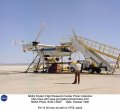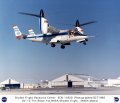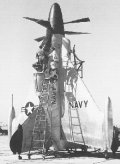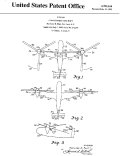
The Bell XV-15 Tiltrotor aircraft were involved in limited research at NASAs Hugh L. Dryden Flight Research Center in 1980 and 1981. This photo shows the XV-15 on its VTOL stand before its first flight in October 1980.

This photo shows the first XV-15 tilt rotor flight for NASA/Dryden Flight Research Center at the Army contingent at Edwards Air Force Base, Edwards, California, October 1980.

The Convair XFY-1 Pogo, developed in 1954, was a "tailsitter" aircraft with two large contra-rotating propellers. It was extremely difficult to control in vertical flight and was grounded in 1956.

The V-22 Osprey operates as a conventional aircraft in forward flight.

The American aircraft company Platt-LePage Aircraft Company applied for a patent for a tilt-rotor aircraft concept in 1955.
|
V/STOL Technology
Vertical and Short Takeoff and Landing (V/STOL) aircraft can take off and land like a helicopter but fly with the efficiency of an airplane. They include both Vertical Takeoff and Landing (VTOL) and Short Takeoff and Landing (STOL) aircraft.
In general, V/STOL aircraft can be divided into several sub-categories. These include props and fans, convertibles/rotorcraft, convertiplanes/propeller, fixed jet, vectored jet, and lift devices. All of them work by diverting a large percentage of their thrust downward in order to lift the aircraft off the ground, and then directing that thrust to the rear in order to fly normally.
Props and fans
These aircraft operate by using a large propeller or fan to lift the aircraft off the ground and also, in some cases, to provide forward thrust. Some of these have been individual craft where a person stands atop a spinning propeller or ducted fan that lifts them off the ground-something that required a lot of courage from the pilot. Others have been aircraft that sit on their tails (so-called "tailsitters") and are lifted into the air before converting to horizontal flight. Still others have used fans buried in their wings and which then fly using a conventional jet engine that faces to the rear. All of these designs have had severe problems and are not efficient.
Convertibles/rotorcraft
These aircraft are similar to helicopters but have additional engines to provide forward thrust. Helicopters can rarely travel faster than 200 miles per hour (322 kilometers per hour) and have limited range. There have been several experimental aircraft developed that attempt to increase the speed of helicopters by mounting forward-thrusting jet engines on their fuselages, often accompanied by short wings. There have also been modern versions of the autogyro. Although these can travel faster than helicopters, they usually suffer many of the limitations of helicopters, such as their relatively short range and low lifting capability.
Convertiplanes/propeller
These aircraft use propellers that tilt horizontally to lift the craft off the ground and vertically to provide thrust, making them look much like normal propeller-driven aircraft when in forward flight. They are probably the most heavily researched areas of V/STOL technology. Usually the propellers are mounted at the tips of wings and both the propellers and their engines rotate. The usual drawback of such aircraft is the complicated mechanism for tilting the engines and the danger of having an engine fail in flight, making landing impossible.
Fixed jet
These aircraft look much like normal jet aircraft but have additional "lift jets" mounted in the fuselage to lift them off the ground. Once in the air, a larger jet engine engages to push the craft forward. Sometimes a combination of engines is used, with the main engine providing some downward thrust and assisted by lift jets, or lift jets providing all the downward thrust when the aircraft is taking off and landing. The biggest drawback for these kinds of aircraft is that they are carrying extra jet engines in flight that they do not normally use except during takeoff and landing.
Vectored jet
These aircraft use the thrust from a jet engine routed through several exhaust ports that can be rotated (or vectored). The exhaust ducts are pointed downward during takeoff and landing to provide greater lift. The ducts are then directed backwards in normal flight to push the craft through the air. While this decreases the amount of weight compared to fixed jet designs, these aircraft still burn a tremendous amount of fuel during takeoff and landing, which limits their range.
Lift devices
Another more successful form of STOL technology involves the use of high lift devices on the wings of conventional-looking aircraft. This allows them to take off and land in much shorter space.
|



